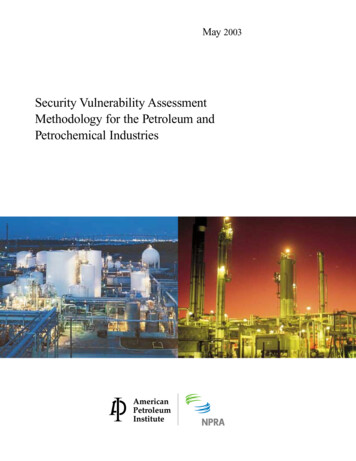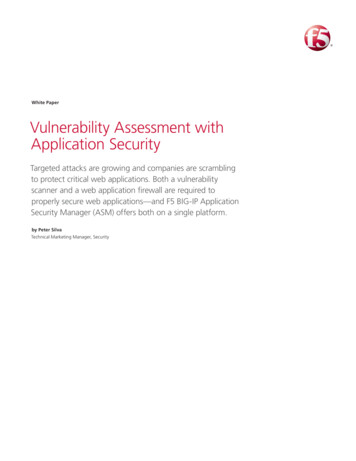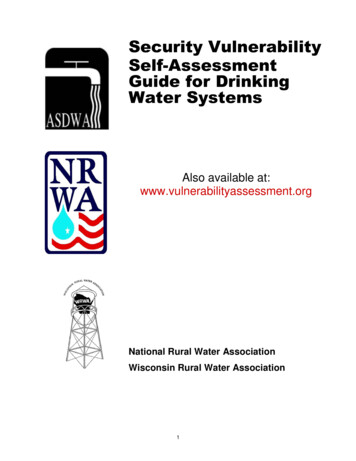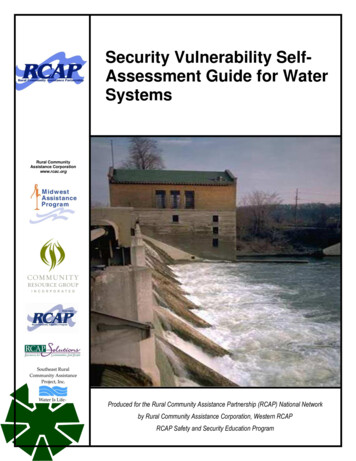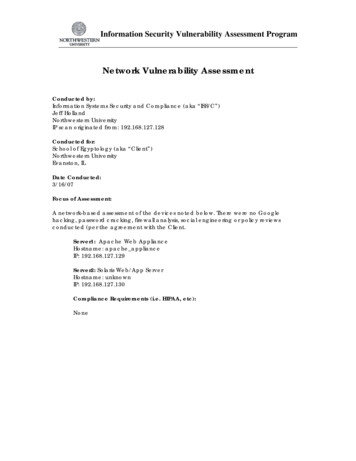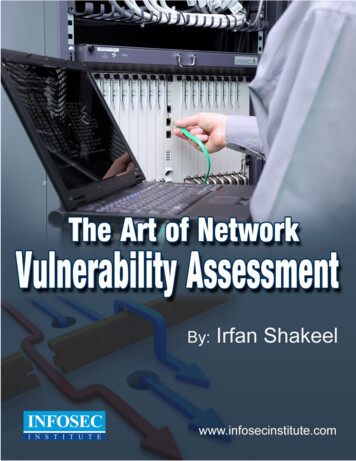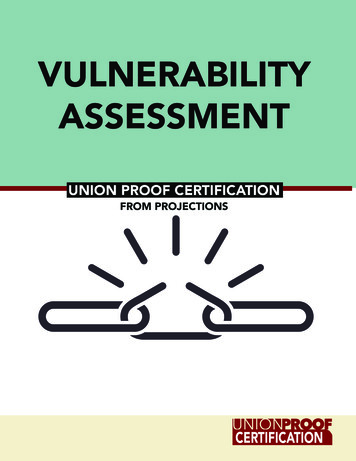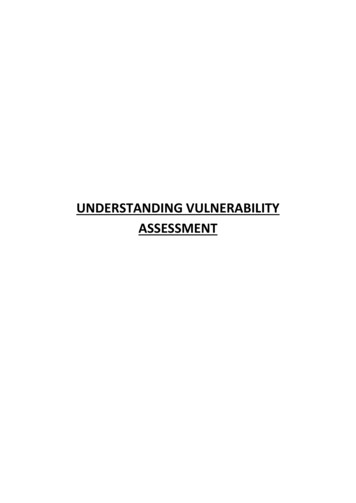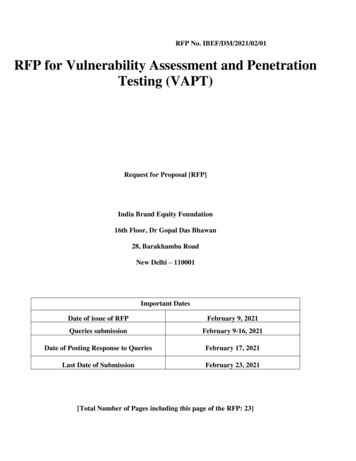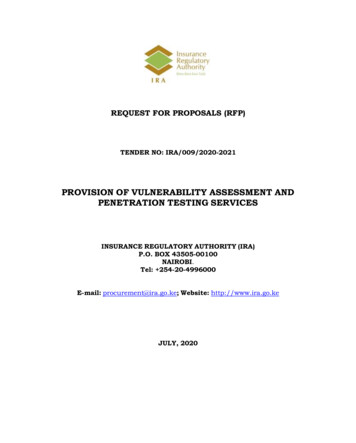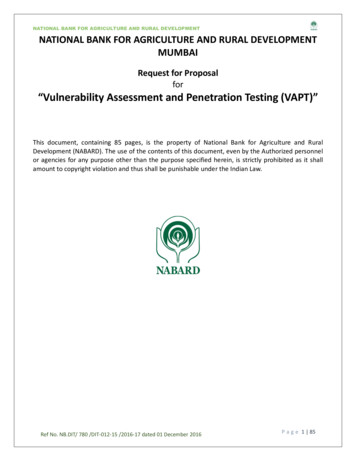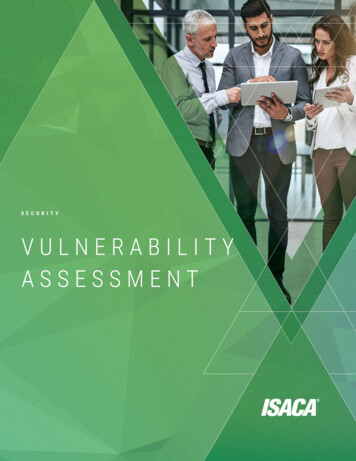
Transcription
1Vulnerability AssessmentS E C U R I T YVULNERABILITYASSESSMENT 2017 ISACA. All Rights Reserved.
2Vulnerability AssessmentCONTENTS4What Is a Vulnerability Assessment?5Types of Vulnerability Assessments11Scoring System and the NationalVulnerability Database5 / Network-Based Scans12 / CVSS and Nontechnical Vulnerabilities6 / Host-Based Scans6 / Wireless Network Scans137 / Application Scans7Appendix B: VulnerabilityAssessment Requirements13 / Payment Card Industry DataBenefits of Vulnerability AssessmentSecurity Standard7 / Security Benefits13 / NIST Special Publication 800-538 / Compliance Requirements8Appendix A: Common Vulnerability14 / NIST Cybersecurity FrameworkWhere Does a Vulnerability14 / CIS Critical Security ControlsAssessment Fit In?14 / ISO/IEC 27002:20139 / Vulnerability Assessments14 / Cloud Security Alliance Cloudand Risk AnalysisControls Matrix9 / Vulnerability Assessments14 / COBIT and Penetration Tests15 / New York State Department of FinancialServices 23 NYCRR 50010Considerations and Possible Risk15 / HIPAA15 / FFIEC Examination15 / NERC Critical Information Protection16 2017 ISACA. All Rights Reserved.Acknowledgments
3Vulnerability AssessmentABSTRACTVulnerability assessment is an integral component of a good security program. In fact,a well-functioning vulnerability management system, including testing and remediation,is often cited by industry standards and regulatory bodies as an essential requirementfor security and mandatory for compliance. This white paper provides an overview ofvulnerability assessments: what they are, how they’re used and the role that they play inensuring an effective and comprehensive audit and security program. 2017 ISACA. All Rights Reserved.
4Vulnerability AssessmentWhat Is a Vulnerability Assessment?The US National Institute of Standards and Technologybased methods, using automated scanning tools to(NIST) defines a vulnerability as “a weakness in anconduct discovery, testing, analysis and reportinginformation system, system security procedures, internalof systems and vulnerabilities. Manual techniquescontrols, or implementation that could be exploited by acan also be used to identify technical, physical andthreat source.” Thus, a vulnerability is a weakness thatgovernance-based vulnerabilities.1can be exploited by adversaries to advance their goals.It should be noted that vulnerability assessmentsTraditionally, cyber security professionals are trainedalone do not prevent security incidents, nor do theirto consider vulnerabilities from a technical perspective,results provide any indication of a current or pastsuch as flaws identified in software platforms orsecurity incident. Conducting an assessment doesconfiguration issues that can be leveraged by an attackernot necessarily improve security on its own; instead, itto gain access. Although, given the definition above,reflects a snapshot of the environment at a particularvulnerabilities encompass weaknesses of all typespoint in time, and its goal is simply to identify and(including, for example, those found within physicalanalyze weaknesses present in a technical environment.environments and governance structures), this paperTo see a net benefit to security, the enterprise mustfocuses on technical issues in software, applications andregularly conduct vulnerability assessments (to track netnetworks, in addition to other technical aspects of theimprovement or failure to improve) and act on the resultscyber security professional’s domain.of those assessments. A vulnerability managementAs a practical matter, it is impossible to remove everytechnical vulnerability from a given environment. Thereare a number of reasons for this. Some vulnerabilities arelatent until they are discovered and publicly disclosed;system (or process) can facilitate identification,analysis and remediation of issues and therebyhelp enterprises realize the value of vulnerabilityassessment itself.these are typically referred to as zero days, referring toVulnerability assessments are not exploitative by naturethe fact that there are zero days since public disclosure.(compared to, for example, ethical hacking or penetrationOther vulnerabilities might persist due to challengestests). In conducting a vulnerability assessment,associated with patching certain devices, including thosepractitioners (or the tools they employ) will not typicallythat support legacy applications or that are directlyexploit vulnerabilities they find. Instead, a vulnerabilitymanaged by external vendors. Still other vulnerabilitiesassessment serves an altogether different purpose: itmight be cost prohibitive to address for other reasons.allows an enterprise to focus on reconnaissance andThis in turn means that any given environment willhave multiple latent vulnerabilities at any given time.A vulnerability assessment is the process of identifyingdiscover weaknesses in its environment. To accomplishthat goal, a suspected vulnerability does not typically needto be exploited to identify its existence and apply a fix.and analyzing those security vulnerabilities that mightFor example, a vulnerability scanner might determine thatexist in the enterprise. Vulnerability assessments area server is missing critical operating system patches bytypically conducted through network-based or host-detecting an outdated version of the operating system1Ross, Ronald S.; Guide for Conducting Risk Assessments, National Institute of Standards and Technology (NIST) Special Publication 800-30, 17 September sk-assessments 2017 ISACA. All Rights Reserved.
5Vulnerability Assessmentduring a network probe. Eliminating that weakness (i.e.,Nonetheless, penetration testing can have a place in athe missing patches) may simply require a softwaresecurity program. It is a regulatory requirement for manyupdate and a reboot. Validating the vulnerability throughenterprises and, in some cases, exploiting a vulnerabilitya penetration test—that is, actually staging and executingcan be necessary to gain an adequate understandingan exploit to prove that the missing patch allows anof risk and develop remediation plans. For example, itattacker to gain access to the server—may not becan serve as a mechanism to overcome organizationalnecessary because the weakness is already known orinertia when issues are viewed as merely theoreticalsuspected by virtue of that missing patch.or, for whatever other reason, are not considered to beConducting a penetration test to prove that the missingpatch is an issue typically increases the cost of testing,runs the risk of potential damage to the system (ordowntime) in the process and can have other broaderimpacts depending on the role and use of the device inserious concerns. Vulnerability assessment can be afirst step in a penetration testing exercise because itprovides the initial intelligence that penetration testersuse to isolate vulnerabilities and then simulate attacks byexploiting them.the environment.Types of Vulnerability AssessmentsNIST Special Publication 800-115, “Technical Guide tovulnerability assessments are typically automated,Information Security Testing and Assessment” is aalthough practitioners should be involved throughoutpractical guide to techniques for information securitythe process to plan, execute and analyze results.2testing and assessment. The standard discusses thefollowing four vulnerability assessment activities:Network-Based Scans Network-based scansNetwork-based scans combine host and service Host-based scans (i.e., system-configuration reviews) Wireless scanscomponent of a network-based scan allows theassessor to identify the devices on a network and, for Application scans (included within penetration testing)These vulnerability assessment scans are usuallyovert—the target has knowledge of the tests and stealthtechniques (to allow the tester to avoid detection) arenot needed. The scans can cover internal or externalsystems. Practitioners can decide whether circumstancesrequire “authenticated testing,” in which the scanningtool is provided with authorized credentials to examinethe system or application at a deeper level. Technical2discovery with vulnerability enumeration. The discoveryeach device, determine its type and potential pointsof attack. To learn the type, the scanning tool probesa target and analyzes its behavior and responses toestablish a “fingerprint” that includes information aboutthe system and allows the tool to determine (with varying degrees of accuracy) the characteristics of the host.For example, the tool might enumerate running services,scan for a range of listening TCP ports, examine systembanners or deploy any number of other techniques todetermine the type and version of the host or device.Scarfone, Karen; Murugiah Souppaya; Amanda Cody; Angela Orebaugh; “Technical Guide to Information Security Testing and Assessment,” NIST Special Publication 800-115, NationalInstitute of Standards and Technology, September 2008, 15/final 2017 ISACA. All Rights Reserved.
6Vulnerability AssessmentFor all but the stealthiest of devices, modern scanningnetwork-based scans; however, that breadth typicallytools can reliably discover the target’s operating systemincreases their overhead and makes them harder to setand network applications, and, from those details,up and operate. Many network-based scanning toolsperform focused tests to identify weaknesses. Forinclude an option for authenticated scans, which areexample, after a tool establishes that a target is runninglikely to implement the Security Content AutomationRed Hat Linux 3 and an Apache webserver,4 it mightProtocol (SCAP)5 and work with the NIST-maintainedthen run a battery of tests focused on knownNational Checklist Program (NCP).6 To meet host-vulnerabilities and common misconfigurations of thathardening requirements, such as those found in theoperating system and application.Payment Card Industry Data Security Standard (PCIDSS),7 host-based scanning is a must-have.Because hackers are almost certain to scanInternet-connected systems—new servers are typicallyscanned within minutes of coming online—proactiveWireless Network Scansvulnerability assessment scanning is critical forWireless scans of an enterprise’s Wi-Fi networks focusInternet-accessible servers. Hackers who gain a footholdon points of attack in wireless network infrastructure.on an internal network can “land and expand” by usingOne aspect of wireless network testing is validatingthe compromised host to identify more vulnerablethat an enterprise’s networks are securely configured.targets, to move laterally throughout the network and toAlthough any benefit of disabling SSID broadcast toattack other systems using the compromised host as a“hide” a network has long since passed, scanningbeachhead. To the extent that scanning can help reducevalidates that strong encryption is enabled and defaultthis possibility, internal scans can help prevent attackssettings are changed. Another purpose of wirelessfrom spreading quickly inside an enterprise.testing is to identify rogue access points, which poseas legitimate wireless networks of either an enterpriseor a hotspot, such as a local coffee shop, to trickHost-Based ScansNetwork-based scans may sometimes miss weaknessesvictims into joining an attacker’s network.that can be exploited only by a user who is logged ontoNetwork-based scans should also be used on wirelessthe system (i.e., local exploits) because they may onlynetworks to detect vulnerable systems. Enterpriseshave the capability or be configured only to look forshould be aware that internal systems may connect“remotely exploitable” vulnerabilities (i.e., those that areto guest wireless networks; an attacker can targetaccessible from somewhere else on the network). Host-systems connected to a guest network and jump tobased scans, by contrast, are executed from the targetinternal networks from there. Guest networks may becomputer or are remotely controlled with authenticatedisolated, but compromised systems connected to theseaccount access to the target computer. These scans cannetworks can still be a worrying attack vector. Further,provide greater visibility into a system’s configuration set-assessors should verify that separate wireless networkstings and patch details, while covering ports and servicesreally are isolated; network administrators may inadver-that are also visible to network-based scans. For thistently allow guest network traffic inside internal networksreason, host-based scans are more comprehensive thanand access to sensitive networks and systems.3Red Hat, Inc., “Linux Platforms,” 2017, www.redhat.com/en/technologies/linux-platforms4The Apache Software Foundation, “HTTP Server Project,” http://httpd.apache.org/5National Institute of Standards and Technology, “Security Content Automation Protocol: SCAP Related Publications,” onal Institute of Standards and Technology, “National Checklist Program,” 13 July 2017, program7PCI Security Standards Council, LLC, “Document Library,” www.pcisecuritystandards.org/document library 2017 ISACA. All Rights Reserved.
7Vulnerability AssessmentApplication ScansApplication scans typically focus on websites to discoveralso include web application security tests, althoughand enumerate software vulnerabilities and misconfigu-they have fewer features that are focused on webrations. During penetration testing, assessors often useapplication testing than DAST tools. Application securitymanual tests or exploit kits; however, software-centrictesting can be risky because scanning software mayDynamic Application Security Testing (DAST) toolsmake changes to databases or delete content duringhelp to identify vulnerabilities that are unique to webtesting, so enterprises should either restrict testingsoftware, such as SQL injection, cross-site scriptingto nonproduction environments or exercise caution in(XSS), insufficient input validation and sensitive datascanning production environments.exposure. Many network vulnerability scanning tools8Benefits of Vulnerability AssessmentLike most information security controls and processes, vulnerability assessments have two driving factors:security benefits and compliance obligations. Fortunately, conducting vulnerability assessments satisfies bothdriving factors.Security BenefitsBecause vulnerability assessment security benefits areused not only to target remediation plans but also tonumerous, industry frameworks and best practice guid-indicate systemic issues, such as gaps in patchance typically include vulnerability assessments in theirmanagement or asset life cycle management. Networklist of suggested measures. For example, the Centervulnerability scans can identify rogue assets connectedfor Internet Security (CIS) lists continuous vulnerabilityto an enterprise network, detect network misconfigura-assessment and remediation as one of the first five CIStions and find unauthorized services running on internalcontrols that reduce the majority of an enterprise’ssystems. In more mature enterprises that already usesecurity risk.9 Similarly, the NIST Cybersecurity Frameworkcentralized logging, vulnerability assessment results cancalls for the identification and documentation of assetbe integrated in event correlation by cross-referencingvulnerabilities in its Identify category of controls.suspicious events with known vulnerabilities; log 10It is not difficult to understand why vulnerability assessments hold a prominent spot in the information securityspace. Assessment tools are relatively easy to install andrun, are largely automated and provide a cost-effectiveway to gain valuable insights into an enterprise’senvironment. Vulnerability assessment results can be8analysts can also use vulnerability scanning activities tounderstand the attack signature that an internal attackermight exhibit during network probes. These usecases can enhance security monitoring capabilities andimprove the chances that a malicious actor is detectedwhen conducting reconnaissance or exploiting a system.The Open Web Application Security Project (OWASP) is a widely recognized resource for web application security guidance. See OWASP, “Welcome to OWASP,” 3 October 2017,https://www.owasp.org/index.php/Main Page9Center for Internet Security ; “CIS Controls: First 5 CIS Controls,” www.cisecurity.org/controls/10 National Institute of Standards and Technology, Framework for Improving Critical Infrastructure Cybersecurity, Draft Version 1.1, 10 January ments////draft-cybersecurity-framework-v1.11.pdf 2017 ISACA. All Rights Reserved.
8Vulnerability AssessmentCompliance RequirementsCompliance requirements can be divided intoevent of security breaches. Noncompulsory driverstwo categories: compulsory and noncompulsory.are not mandated; however, for some enterprises,Compulsory drivers are government- or industry-expectations from customers, clients or businessmandated requirements to which an enterprisepartners may force compliance with standards, suchmust adhere, such as a law or regulation. Commonas ISO/IEC 27001:2013 Information technology –examples of compulsory compliance objectivesSecurity techniques – Information security managementinclude the Health Insurance Portability and Accountabilitysystems – Requirements,14 NIST SP 800-53 Security andAct (HIPAA), the General Data Protection RegulationPrivacy Controls for Federal Information Systems and(GDPR) and the recent Cybersecurity RequirementsOrganizations15 and the Health Information Trust Alliancefor Financial Services Companies regulation from the(HITRUST) CSF. 161112New York State Department of Financial Services.13Vulnerability assessments are included, explicitly orThe PCI DSS is an example of an industry-mandatedimplicitly, in most compulsory and noncompulsory cybercompulsory requirement. Although not governmentsecurity standards. Because not all such standards canmandated, all credit card merchants and providers arebe covered in this section, Appendix B Vulnerabilitycontractually obligated to comply with the PCI DSS.Assessment Requirements provides a list of regulations,Compulsory compliance objectives almost alwaysstandards and frameworks that set vulnerabilitypresent a financial penalty for noncompliance or in theassessment expectations.Where Does a VulnerabilityAssessment Fit In?Although vulnerability assessments are often conductedassessments can be used tactically to determine areasas standalone activities, the results of a vulnerabilitywhere operating system patches need to be applied orassessment can be used as input to other commonconfiguration updates need to be made. They can alsosecurity functions, such as enterprise risk analysis andbe used more strategically as a measuring instrumentpenetration testing. Vulnerability assessments can havefor the health of the patch management and configurationtactical or strategic purposes or both. For example,management efforts of the overall enterprise.11 U.S. Department of Health & Human Services, “Health Information Privacy,” www.hhs.gov/hipaa/index.html/12 EU GDPR Portal, “GDPR Portal: Site Overview,” www.eugdpr.org/13 New York State Department of Financial Services, “Cybersecurity Requirements for Financial Services Companies,” 23 NYCRR s/atoms/files/Cybersecurity Requirements Financial Services 23NYCRR500.pdf14 International Organization for Standardization, “Information technology -- Security techniques -- Information security management systems – Requirements,” ISO/IEC27001:2013, October 2013, www.iso.org/standard/54534.html15 National Institute of Standards and Technology, “Security and Privacy Controls for Federal Information Systems and Organizations,”
A vulnerability management system (or process) can facilitate identification, analysis and remediation of issues and thereby help enterprises realize the value of vulnerability assessment itself. Vulnerab
